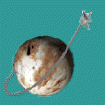
Current Issues:
SpaceViews
SpaceViews Update
Breaking News
Back Issues
Search
Subscriptions
Submissions
Forum
Space Sites of the Week
Home
Comet Hale-Bopp
Top Ten Stories of '96
Life on Mars?
Mars Pathfinder
Space Station Mir
Cassini Opponents Mobilize Forces
Anti-nuclear activists who are opposed to the 33 kg (72 lbs.) of plutonium carried by the Cassini spacecraft sought to gain support for their efforts to prevent the launch of the spacecraft scheduled next month.
![[image of Cassini]](../970915/images2/cassini.jpg) At a September 8 press conference, key anti-Cassini activists claimed an accident during the launch of Cassini or during an Earth flyby two years later could kill thousands or millions of people from radiation exposure from the spacecraft's plutonium.
At a September 8 press conference, key anti-Cassini activists claimed an accident during the launch of Cassini or during an Earth flyby two years later could kill thousands or millions of people from radiation exposure from the spacecraft's plutonium.
"A launch pad explosion similar to the Challenger could kill thousands from cancer and other radiation induced diseases," claimed Bruce Gagnon of the Florida Coalition for Peace and Justice, one of the leading anti-Cassini organizations. Gagnon said an accident during the August 1999 Earth flyby "could rain down plutonium dust across much of the Earth's surface, resulting in millions of deaths for decades to come."
NASA and independent experts have said the chance of a launch accident is very small, and the heavily shielded radioisotope thermoelectric generator (RTG) is unlikely to break open, even in a catastrophic explosion. NASA also said the chance of an accidental reentry of Cassini in Earth's atmosphere is less than one in a million.
Anti-Cassini activists have not been convinced by NASA's reports. "I find that the NASA bureaucrats are living in fantasyland," said Michio Kaku, who is a theoretical physicist at the City University of New York. "Many of these numbers [from NASA studies] are simply made up," he claimed.
Cassini carries the RTGs to provide electrical power at Saturn's distances from the Sun, distances at which solar panels would not work, NASA reports, even given new advances in solar cell efficiency. RTGs have been used in a number of major missions, including the two Voyager missions and Galileo, without problems.
The anti-Cassini forces are planning a series of protests in New York, Washington, and Cape Canaveral. Groups involved in the protest have also discussed non-violent efforts to gain access to the launch site and sit on the launch pad.
Pro-Cassini forced have also been mobilizing their forces. The National Space Society has created a new online section, the cyberSPACE news, with information about the launch and information and tips for pro-Cassini activists. The site on the Web at http://www.nss.org/cyberspace.
The Planetary Society has also spoken out in favor of the launch. "We believe not launching Cassini would be an enormous financial, intellectual, and exploratory loss," executive director Louis Friedman said in a statement. "The public can take satisfaction in knowing that NASA is being careful, prudent, and smart as we move forward and outward beyond Earth."
The Planetary Society also called on those who support the mission to call or e-mail the White House on September 15, a date anti-Cassini activists set as a date to contact the White House and express their opposition to the mission.
